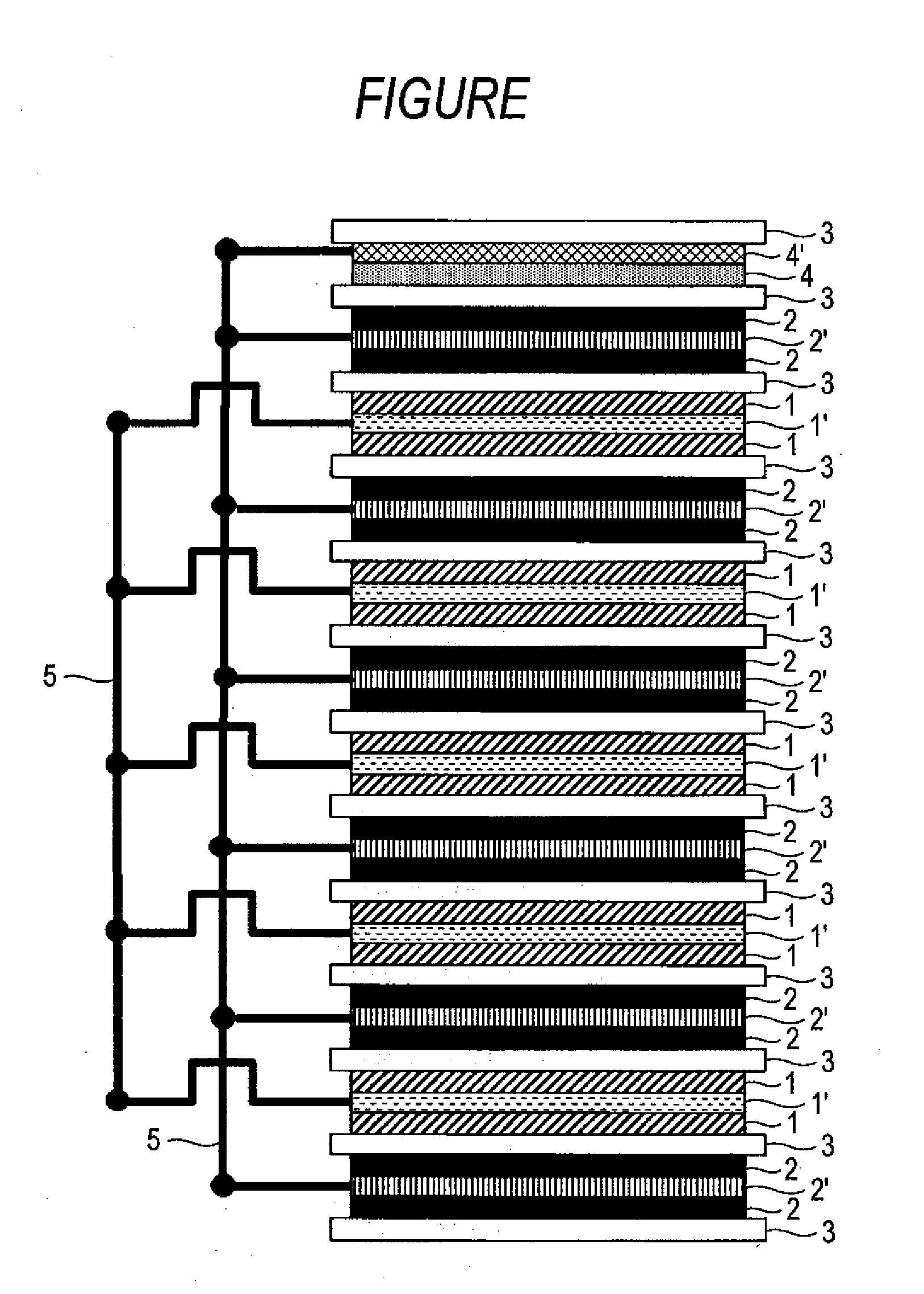Lithium ion capacitor
a technology capacitors, applied in the field of lithium ion capacitors, can solve the problems of poor productivity, achieve high output density, high energy density, and high productivity
- Summary
- Abstract
- Description
- Claims
- Application Information
AI Technical Summary
Benefits of technology
Problems solved by technology
Method used
Image
Examples
example 1
Producing Method of Negative Electrode 1
[0075]A 0.5 mm thick phenol resin molded plate is put in a siliconit electric furnace, heated in a nitrogen atmosphere to 500° C. at a temperature-up speed of 50° C. / hr, followed by further heating to 660° C. at a temperature-up speed of 10° C. / hr, further followed by heat-treating, thereby a PAS is synthesized. Thus obtained PAS plate is pulverized by a disc mill to obtain a PAS powder. The H / C ratio of the PAS powder is 0.21. In the next place, 100 parts by weight of the PAS powder and a solution where 10 parts by weight of polyvinylidene fluoride powder is dissolved in 80 parts by weight of N-methylpyrrolidone are thoroughly mixed to obtain a slurry. The slurry is coated by use of a doctor blade on one surface of a copper foil having a thickness of 18 μm at substantially 7 mg / cm2 as a solid content, dried and pressed, and, thereby a PAS negative electrode 1 is obtained.
(Producing Method of Positive Electrode 1)
[0076]Then, 100 parts by weigh...
example 2
Producing Method of Positive Electrode 5
[0100]On an aluminum foil having a thickness of 50 μm, which is used in an electrolytic capacitor and provided with irregularity on a surface thereof by means of electrolytic etching, through-holes having a diameter of 50 μm are formed by means of a laser. An average diameter of inscribed circles of the through-holes is 50 μm. An aperture ratio of such an aluminum foil is 30%. The slurry of a positive electrode 1 is horizontally coated on one surface of the porous aluminum foil by a roll coater at the speed of 5 m / min, followed, after molding and drying, by further horizontally coating on the other surface by a roll coater at the speed of 5 m / min. After drying and pressing, a positive electrode 5 of which total thickness (a sum total of thicknesses of the positive electrode layers on both sides and a thickness of the positive electrode current collector) is 295 μm is obtained.
(Preparation of Cell 4)
[0101]Except that the positive electrode 5 is...
example 3
Producing Method of Negative Electrode 3
[0106]A copper foil (produced by Nihon Seihaku K. K.) having a thickness of 18 μm is processed by a laser to form through-holes having an average diameter of inscribed circles of 80 μm and thereby, as negative electrode current collector, a porous copper foil having the aperture rate of 30% is obtained. The slurry of the negative electrode 1 is horizontally coated on one surface of the porous copper foil by a roll coater at a speed of 5 m / min, molded and dried, followed by further horizontally coating on the other surface by a roll coater at a speed of 5 m / min, further followed by drying and pressing, thereby a negative electrode 3 having a thickness (sum total of thicknesses of negative electrode layers on both sides and a thickness of a negative electrode current collector) of a whole negative electrode of 151 μm is obtained.
(Preparation of Cell 5)
[0107]Except that the negative electrode 3 is used, similarly to example 1, 4 cells of film typ...
PUM
 Login to View More
Login to View More Abstract
Description
Claims
Application Information
 Login to View More
Login to View More - R&D
- Intellectual Property
- Life Sciences
- Materials
- Tech Scout
- Unparalleled Data Quality
- Higher Quality Content
- 60% Fewer Hallucinations
Browse by: Latest US Patents, China's latest patents, Technical Efficacy Thesaurus, Application Domain, Technology Topic, Popular Technical Reports.
© 2025 PatSnap. All rights reserved.Legal|Privacy policy|Modern Slavery Act Transparency Statement|Sitemap|About US| Contact US: help@patsnap.com



